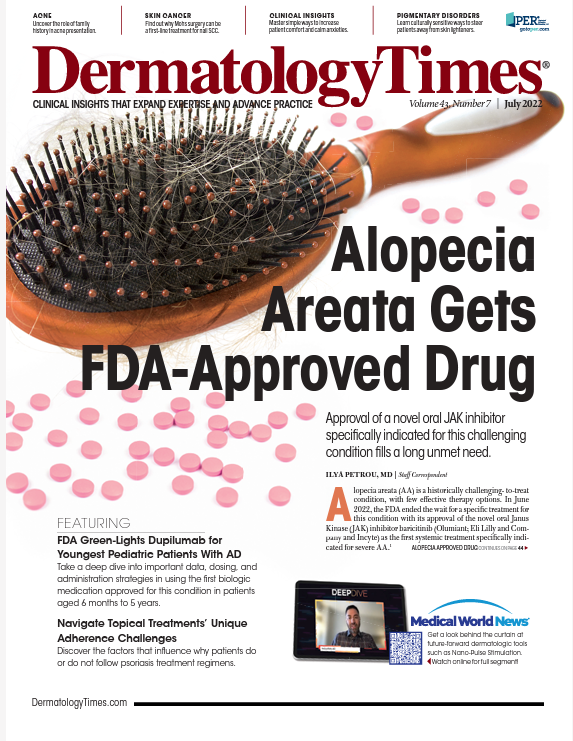- Case-Based Roundtable
- General Dermatology
- Eczema
- Chronic Hand Eczema
- Alopecia
- Aesthetics
- Vitiligo
- COVID-19
- Actinic Keratosis
- Precision Medicine and Biologics
- Rare Disease
- Wound Care
- Rosacea
- Psoriasis
- Psoriatic Arthritis
- Atopic Dermatitis
- Melasma
- NP and PA
- Skin Cancer
- Hidradenitis Suppurativa
- Drug Watch
- Pigmentary Disorders
- Acne
- Pediatric Dermatology
- Practice Management
- Prurigo Nodularis
- Buy-and-Bill
Publication
Article
Dermatology Times
Innovation in Psoriasis Therapies
Author(s):
In a hard-hitting session from the 2022 Fall Clinical Dermatology Conference for PAs & NPs, April Armstrong, MD, MPH, dove into PAD technology and future innovations in psoriasis treatment.
At the 2022 Fall Clinical Dermatology Conference for PAs & NPs, held June 3 to June 5, in Scottsdale, Arizona, April Armstrong MD, MPH, a professor of dermatology and associate dean of clinical research at the Keck School Faculty of University of Southern California, in Los Angeles, dove into Poly-Aphron Dipersion (PAD) technology to help drive combination treatment in psoriasis.1
PAD technology helps solve the issue of the pH incompatibility of calcipotriene (CAL) and betamethasone (BDP)—with BDP requiring a pH of 4 to 6 and CAL requiring a pH of 8 or greater to be effective—by producing separate, but stable droplets of each, according to Armstrong.2 The PAD technology droplets require low levels of surfactant, Armstrong explained, thus having less potential for irritation.3
This technology combined with the 0.005% CAL and 0.064% BDP cream (Wynzora; MC2 Therapeutics), which was FDA-approved in July 2020 to treat patients with plaque psoriasis, demonstrated efficacy in a recent study.4 When the 0.005% CAL and 0.064% BDP cream was compared to the non-PAD technology using CAL/BDP gel in a phase 3 trial at 8 weeks. Data showed that patients receiving the cream achieved greater physician global assessment (PGA) success than the gel—43.2% vs 31.9% respectively.
This 0.005% CAL and 0.064% BDP cream was also studied for scalp psoriasis. In a pooled analysis of 2 phase 3 multicenter, randomized, investigator-blind, active, and vehicle-controlled trials (NCT03308799) (NCT03802344) comparing the cream to a vehicle in patients (n=1271), investigators found the 50.8% of those who received the cream vs 9.3 % of patients in the vehicle group met PGA success, respectively, at 8 weeks.5
This success was demonstrated further in the Psoriasis Area Severity Index (PASI) 75 scores and the Dermatology Life Quality Index (DQLI), with 42.3% of patients achieving PASI 75 and 45.9% achieving DQLI of 0 or 1 in the CAL BDP cream group (p=.0008, p=.0016, respectively.)5
Armstrong also covered tapinarof cream 1%, (Vtama; Dermavant Sciences), which was approved by the FDA on May 24, 2022 to treat plaque psoriasis in adult patients with the condition.6 This aryl hydrocarbon receptor agonist is the first steroid-free topical that is FDA-approved in this class of treatments. She showed results from the PSOARING 1 (NCT03956355), PSOARING 1 (NCT03983980) and PSOARING 3 (NCT04053387) phase 3 clinical trials for the cream, all of which found the treatment to be safe and effective in patients with psoriasis.7,8
In PSOARING 1 and PSOARING 2, the primary endpoint in both studies was PGA response of clear (0) or almost clear (1) at week 12 and a 2 or greater grade improvement in PGA score from baseline to week 12. In these trials, 35.4% and 40.2% of patients on tapinarof cream 1% met treatment success at week 12 in trial 1 and 2 respectively.7 There was also treatment success in 36.1% and 47.6% of patients on tapinarof cream 1% who reached PASI 75.7 In PSOARING 3, it was found that the median duration of remittive effect of 115 days.8
On the horizon is topical roflumilast cream (ARQ-154, Arcutis Biotherapeutics Inc), Armstrong noted. This selective and highly potent phosphodiesterase-4 (PDE4) inhibitor was formulated for use on all areas of the body. The FDA assigned the application a PDUFA target action date of July 29, 2022.9
Disclosures
Armstrong is a research investigator and/or scientific advisor to AbbVie, Almirall, Arcutis Biotherapeutics, ASLAN Pharmaceuticals, Beiersdorf, Boehringer Ingelheim, Bristol Meyer Squibb, Janssen Pharmaceuticals, Eli Lilly & Company, Nimbus Therapeutics, LLC, Novartis, Ortho Dermatologics, Sun Pharma, Dermavant Sciences, Inc, Dermira, Sanofi, Regeneron Pharmaceuticals, Inc, and Modernizing Medicine.
References
- Armstrong A. Efficacy and safety of new psoriasis therapies. Presented at: 2022Fall Clinical Dermatology Conference for PAs & NPs; June 3-5, 2022; Scottsdale, AZ.
- Vakirlis N, Acar O, Hsu B, et al. De novo emergence of adaptive membrane proteins from thymine-rich genomic sequences. Nat Commun. 2020;11(1):781. doi:10.1038/s41467-020-14500-z
- Pinter A, Green LJ, Selmer J, et al. A pooled analysis of randomized, controlled, phase 3 trials investigating the efficacy and safety of a novel, fixed dose calcipotriene and betamethasone dipropionate cream for the topical treatment of plaque psoriasis. J Eur Acad Dermatol Venereol. 2022;36(2):228-236. doi:10.1111/jdv.17734
- FDA approves wynzora cream for plaque psoriasis. Press release. Published July 22, 2020. Accessed June 3, 2022. https://www.psoriasis.org/advance/fda-approves-wynzora-cream-plaque-psoriasis/
- Armstrong A, Pinter A, Selmer J, et al. Pooled analysis demonstrating superior patient- reported psoriasis treatment outcomes for calcipotriene/ betamethasone dipropionate cream versus suspension/gel. J Drugs Dermatol. 2022;21(3):242-248. doi:10.36849/JDD.661
- FDA approves Dermavant’s Vtama (Tapinarof) cream, 1% for the treatment of plaque psoriasis in adults: first topical novel chemical entity launched for psoriasis in the US In 25 years. GlobeNewswire News Room. Published May 24, 2022. Accessed June 3, 2022. https://www.globenewswire.com/news-release/2022/05/24/2449068/34323/en/FDA-Approves-Dermavant-s-VTAMA-tapinarof-cream-1-for-the-Treatment-of-Plaque-Psoriasis-in-Adults-First-Topical-Novel-Chemical-Entity-Launched-for-Psoriasis-in-the-U-S-in-25-Years.html
- Lebwohl MG, Stein Gold L, Strober B, et al. Phase 3 trials of tapinarof cream for plaque psoriasis. N Engl J Med. 2021;385(24):2219-2229. doi:10.1056/NEJMoa2103629
- Tapinarof in the treatment of psoriasis: A review of the unique mechanism of action of a novel therapeutic aryl hydrocarbon receptor–modulating agent. J Am Acad Dermatol.2021;84(4):1059-1067. doi:10.1016/j.jaad.2020.10.085
- Arcutis announces first quarter 2022 financial results and provides business update. Arcutis Biotherapeutics. Published May 5, 2022. Accessed June 3, 2022. https://www.arcutis.com/arcutis-announces-first-quarter-2022-financial-results-and-provides-business-update/







